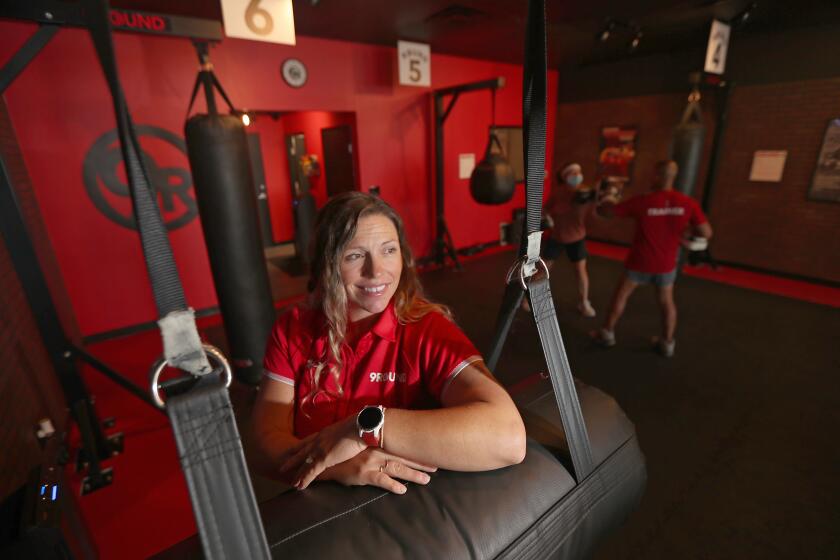U.S. consumer spending rises 1% in June as inflation remains high

- Share via
American consumers increased their spending by 1% in June — a dose of energy for an economy that is quickly rebounding from the pandemic recession but is facing new risks led by the Delta variant of the coronavirus.
At the same time, a key inflation barometer that is closely followed by the Federal Reserve surged 3.5% last month from a year earlier. That was the fastest such 12-month surge since 1991.
June’s solid increase in consumer spending provided further evidence that consumers are driving a strengthening recovery from the pandemic recession.
Friday’s report from the Commerce Department also showed that personal incomes, which provide the fuel for spending, edged up 0.1% in June after two months of big declines, reflecting the waning of several government support programs.
In its report on consumer spending in June, the government said that goods purchases rose a modest 0.5%, while spending on services increased a stronger 1.2%. As vaccinations have increased and the economy has increasingly reopened, more Americans have been shifting their spending away from the physical goods that many purchased while hunkered down at home to spending on services, from haircuts to airline tickets to restaurant meals.
As a whole, household spending has been powering a robust recovery from the pandemic recession. On Thursday, the government estimated that the economy grew at a solid 6.5% annual rate last quarter — and consumer spending drove much of the gain: It advanced at an powerful 11.8% annual rate in the April-June quarter as more Americans left home to shop, travel and eat out.
The rise in spending has fueled businesses’ need for workers, and in many cases they can’t find enough people to fill jobs. Still, last month, America’s employers added a robust 850,000 jobs, and average hourly pay rose a solid 3.6% compared with a year earlier, faster than the pre-pandemic annual pace.
Employers in California and the U.S. are scrambling to fill jobs as the dust from the pandemic begins to settle. Just don’t call it a labor shortage.
Yet the economy’s prospects are now clouded by the threat of a resurgent coronavirus in the form of the highly contagious Delta variant. The U.S. is now averaging about 67,000 confirmed new cases a day, up from only about 12,000 a month ago. Should a surge in infections cause many consumers to retreat back to their homes and pull back on spending, it would weaken the recovery.
But many analysts say they think any economic damage inflicted by the Delta variant will be offset by consumers still eager to spend some of the savings they accumulated during the pandemic lockdowns. The savings rate in June — 9.4% of after-tax incomes — represents a high level compared with pre-pandemic rates. During the months of lockdowns, households cut back on their debt and accumulated a hefty $2.5 trillion in savings.
“Consumers have very strong balance sheets coming out of the pandemic, which will fuel strong consumer spending and economic growth in the next few years,” said Bill Adams, senior economist at PNC Financial. He noted that the surge in COVID-19 cases was occurring primarily in Southern states that are less likely to reimpose restrictions on businesses.
Adams said he believed that continued strong consumer spending in the second half of the year would increase economic expansion for the year as a whole to around 6.6%. That would mark the strongest calendar year growth since the mid-1980s.
At the same time, though, rising inflation poses another risk to optimistic forecasts. The inflation index that showed a 3.5% year-over-year rise for June — an index that the Fed monitors most closely — excludes volatile food and energy prices. A separate price index that includes all such items rose by an even larger 4% over the past 12 months. That was the largest such increase since 2008.
But at a news conference this week, Fed Chair Jerome H. Powell underscored his belief that recent inflation readings reflect mainly temporary price spikes in a narrow range of categories — from used cars and airline tickets to hotel rooms and auto rentals — that have been distorted by supply shortages related to the economy’s swift reopening. Those shortages involve items like furniture, appliances, clothing and computer chips, among others.
“Price pressures should abate over coming months as supply chain dislocations ease,” agreed Rubeela Faroqui, chief U.S. economist at High Frequency Economics.
The Biden administration is predicting that consumers will keep spending and provide vital support for the economy for the rest of this year, even as trillions of dollars in government support wind down.
Many outside economists agree. Millions of households will continue to receive child tax credit payments that have begun to be distributed. And many affluent households have benefited from a vast increase in their wealth resulting from surging home equity and stock market gains and seem inclined to spend some portion of it.
The economy is also receiving substantial support from the Fed. This week, the central bank reaffirmed that it will maintain its key short-term interest rate at a record low near zero to keep short-term borrowing costs low. It will also continue to buy government-backed bonds to put downward pressure on long-term loan rates to encourage borrowing and spending.
More to Read
Sign up for Essential California
The most important California stories and recommendations in your inbox every morning.
You may occasionally receive promotional content from the Los Angeles Times.














